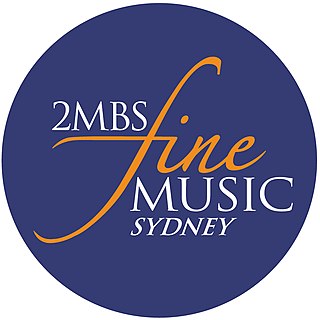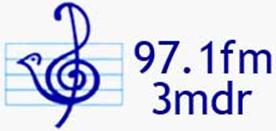Related Research Articles

Shortwave radio is radio transmission using shortwave (SW) radio frequencies. There is no official definition of the band, but the range always includes all of the high frequency band (HF), which extends from 3 to 30 MHz ; above the medium frequency band (MF), to the bottom of the VHF band.

KIIS 1011 is a commercial FM radio station broadcasting in Melbourne, Victoria, Australia, on a frequency of 101.1 MHz and is the Melbourne affiliate of ARN's KIIS Network. The station was formerly known as 3DB and 3TT, broadcasting on 1026 kHz AM, before converting to FM in 1990.

ABC Radio Melbourne is an ABC Local Radio station in Melbourne, Australia. It began transmission on 13 October 1924, and was Melbourne's second licensed radio station after 3AR.

2MBS Fine Music Sydney is a Sydney music radio station operated by the Music Broadcasting Society of New South Wales Co-Operative Limited. Launched on 15 December 1974, it is Australia's first fully licensed FM radio station and it has since reached over 630,000 listeners.
Radio broadcasting began in New Zealand in 1922, and is now dominated by almost thirty radio networks and station groups. The Government has dominated broadcasting since 1925, but through privatisation and deregulation has allowed commercial talk and music stations to reach large audiences. New Zealand also has several radio stations serving Māori tribes, Pacific Island communities, ethnic minorities, evangelical Christians and special interests.
Australian radio audiences have had virtually no exposure to pirate radio. There were no broadcasts as part of the World War II propaganda campaigns and commercial as well as community stations alongside the taxpayer funded Australian Broadcasting Corporation were available during the mid to late 1980s and early 1990s - a period when the UK was experiencing a surge in illegal broadcasts during the early days of acid house and the Second Summer of Love. The absence of pirate radio in Australia is primarily attributed to the relatively large number of commercial licences that were issued, particularly after World War 2, as well as the existence of public non-commercial broadcasting licenses supported mainly by listener subscription. Additionally, the lack of availability of imported broadcasting equipment and the likely application of severe, legislated penalties including jail for offenders, would also have been a factor.

FM broadcasting is a method of radio broadcasting using frequency modulation (FM). Invented in 1933 by American engineer Edwin Armstrong, wide-band FM is used worldwide to provide high fidelity sound over broadcast radio. FM broadcasting is capable of higher fidelity—that is, more accurate reproduction of the original program sound—than other broadcasting technologies, such as AM broadcasting. It is also less susceptible to common forms of interference, reducing static and popping sounds often heard on AM. Therefore, FM is used for most broadcasts of music or general audio. FM radio stations use the very high frequency range of radio frequencies.

3MDR is one of many community radio stations broadcasting in Melbourne, Victoria, Australia. covering the Shire of Yarra Ranges and Shire of Cardinia from a studio located in Upwey.

3ZZZ is an ethnic community radio station in Melbourne, Victoria that currently broadcasts programs in over 70 languages on 92.3 MHz FM and is licensed to Mount Dandenong.
Hobart FM is a radio station in Hobart, Australia broadcasting on 96.1 MHz and 92.1 MHz. They do not provide a track list.
94.7 The Pulse, is a community radio station which broadcasts to the Geelong, Victoria region in Australia.
4MBS Classic FM is an Australian community radio station which broadcasts classical music from Brisbane at a frequency of 103.7 MHz and on digital radio and online.

ABC Radio and Regional Content, later ABC Radio, was the division of the Australian Broadcasting Corporation responsible for radio output and regional content.
PBS 106.7FM, also known as the Progressive Broadcasting Service, is a co-operatively owned community radio station in Melbourne, Australia, that broadcasts on 106.7FM, Digital radio and online. PBS celebrated its 40th year of broadcast in 2019.

87.8 UCFM is an independent student radio station transmitting from the campus of the University of Canberra. It broadcasts a professionally consulted College Radio niche music format - 24 hours a day, seven days a week, with a mix of news and current affairs. The radio station's studios are located within the lower level of "The Hub" complex on the university's Bruce campus, in Australia's capital city - Canberra.
Digital broadcast radio in Australia uses the DAB+ standard and is available in Sydney, Melbourne, Brisbane, Perth, Adelaide, Canberra, Darwin and Hobart. However, after 11 years, regional large cities such as Townsville and Ballarat still do not have DAB. The national government owned television/radio networks, the ABC and SBS, and the commercial radio stations in each market provide many of their services and a few digital-only services on the digital platform. Australia uses the AAC+ codec provided with upgraded DAB+ standard.
Hitz 247 is a youth contemporary hit radio-formatted internet radio station, based in Melbourne, Victoria, Australia. Founded by Andrew Gyopar and born out of former aspirant community station Hitz FM, the station began streaming online on 30 December 2011.
5MBS is a community radio station based in Adelaide, Australia and located in Hindmarsh, South Australia. It broadcasts on 99.9 MHz across much of the Adelaide metropolitan area, as well as a live stream via its website. 5MBS is run by volunteers, with no paid staff and is funded by contributions made by its listeners.
References
- ↑ "FM 103.5 Classical Community Radio Station: Website information: Australia's Culture and Recreation Portal". Archived from the original on 21 July 2008. Retrieved 14 March 2008.
- ↑ http://www.finemusic.net.au
- ↑ "CBOnline". Archived from the original on 7 November 2007. Retrieved 9 December 2007.
- ↑ "A third program of Serious music". 3MBS website. Archived from the original (jpg) on 28 August 2007. Retrieved 9 December 2007.
- ↑ "About Us". 3MBS website. Archived from the original on 3 January 2008. Retrieved 9 December 2007.
- ↑ 3MBS Box Office - Your Ticket to the Arts. [ permanent dead link ]
- ↑ 3MBS Radio.